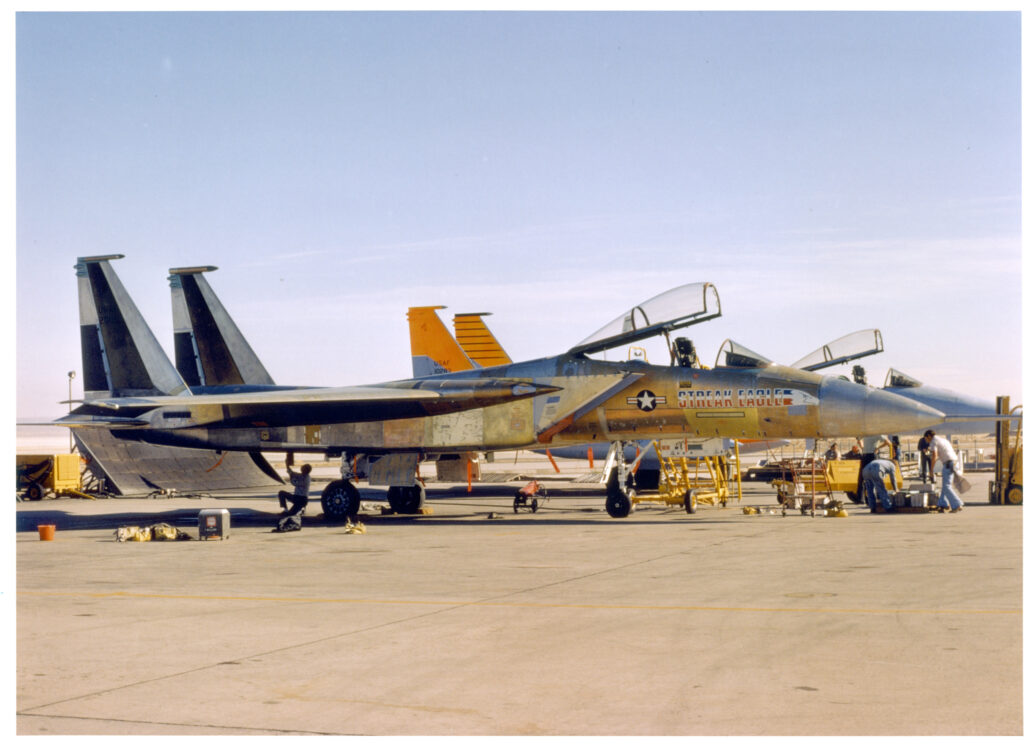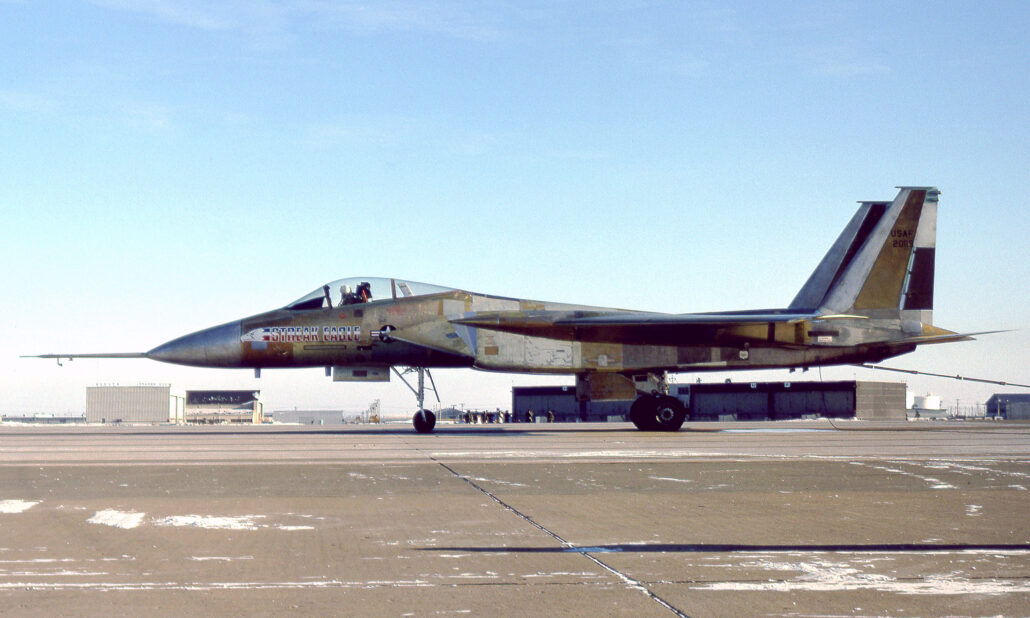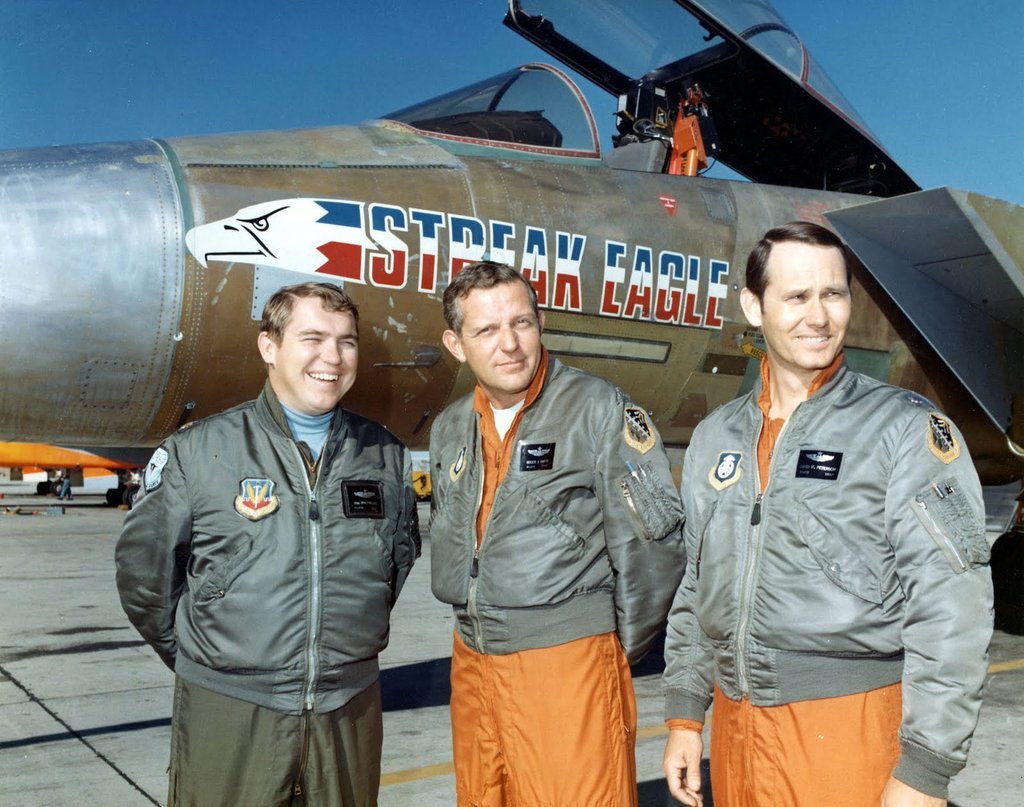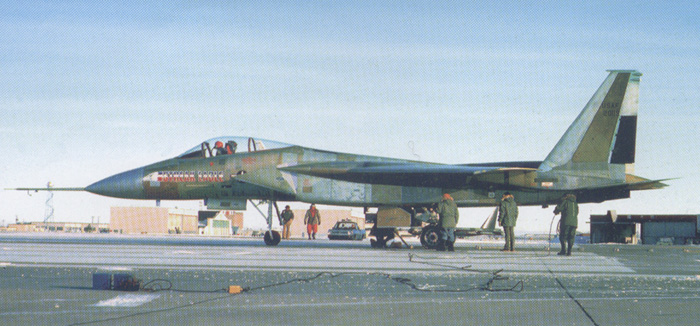For two weeks beginning on Jan. 16, 1975, three Air Force pilots and a modified McDonnell Douglas Aircraft Division (McAir) F-15A-6-MC (72-119) made an assault on the world class time-to-climb for aircraft powered by jet engines.
The three pilots, Maj. Roger Smith, Maj. W. R. ‘Mac’ Macfarlane, and Maj. Dave Peterson were all members of the F-15 Joint Test Force at Edwards. Pete Garrison, a McAir pilot, was instrumental in the development of the flight profiles used for the records.
Project Streak Eagle had three major objectives:
1. To enhance Air Force esprit de corps and morale, and to foster the attractiveness of an Air Force career in support of recruiting objectives,
2. To help establish the credibility of Air Force general purpose forces as an integral element of the United States’ overall military posture,
3. To provide data on the F-15’s capabilities at the extremes of altitudes and performance under controlled test conditions.

The Air Force awarded McAir a $2.1 million dollar contract on April 1, 1974 for aircraft modifications and general support, with configuration approval on May 18, 1974. All test aircraft then in inventory were evaluated, and the choice narrowed between F5 (71-284) and F17 (72-119). Several items led the choice of 72-119: it was 800 pounds lighter than F5; it was an Air Force (Cat II) aircraft as opposed to a contractor (Cat I) aircraft and its absence would have less of an impact on the test program (in fact, it was an unneeded attrition aircraft); and since F17 was just rolling down the production line fewer things would have to be ‘undone’. The aircraft was modified by McAir between April 27 and June 11, 1974 for the tests by deleting all non-mission critical systems including: the flap and speed brake actuators; internal armament; the radar and fire-control system; non-critical cockpit displays and radios; one of the generators; the utility hydraulic system; and, of course, the 50 pounds of paint (hence its name). Additions included: a revised oxygen system; support equipment for the full pressure suit worn by the pilots; extra batteries; a long pitot boom with alpha and beta vanes; an over-the-shoulder video camera; a battery powered radio; sensitive g meters; a standby attitude gyro; a large VHF antenna under the canopy behind the pilot; and a special ‘hold-down’ device in place of the tail hook. The final result was an aircraft that weighed 1,800 pounds less than the other block-6 aircraft. When weighed, in preparation for a 30,000 meter run (on test flight #37), 72-119 weighed 36,799 pounds. Simulations, primarily of the high-altitude profiles, were run between May 3 and Sept. 30, and the application to the Federation Aeronautique Internationale (FAI) was made on Sept. 15, 1974. The flight profile for the 30,000 meter (98,425 feet) record was as follows:
Release from the hold-down cable at full afterburner with 7,000 pounds of fuel
Gear up and rotate at 70 knots (3 seconds after release)
At 420 knots, rotate vertically into an Immelmann and hold 2.65 g
Expect to arrive level, upside down, at 32,000 feet and 1.1 Mach
Rotate to right side up, accelerate to 600 knots while climbing to 36,000 feet
Accelerate to 2.25 Mach and pull 4.0 g to a 60 degree climb angle
Hold 60 degree climb
Shut down the afterburners when they quit
Shut down the engines when they flame-out
Ride ballistically over the top at 55 knots and 103,000 feet
Descend at a 55 degree dive angle
When below 55,000 feet, try to start the engines
Go Home.

The record runs were accomplished at Grand Forks AFB, North Dakota, where the cold atmospheric conditions were ideal. Six different record flights were flown (there were several unsuccessful ones in between), and margins of between 15 and 33 percent were achieved over the previous records. For the record attempts, the aircraft was physically held-down to the runway while full power was applied. The actual records set by Streak Eagle were:
Altitude Date Pilot Old Record Goal Actual (meters)
3,000 16 January 1975 Smith 34.50 27.00 27.57
6,000 16 January 1975 Macfarlane 48.80 38.60 39.33
9,000 16 January 1975 Macfarlane 61.70 47.90 48.86
12,000 16 January 1975 Macfarlane 77.10 58.00 59.38
15,000 16 January 1975 Peterson 114.50 73.70 77.02
20,000 19 January 1975 Smith 169.80 126.10 122.94
25,000 26 January 1975 Peterson 192.60 163.70 161.02
30,000 1 February 1975 Smith 243.90 206.90 207.80

A highly modified MiG-25 (E-266) has since retaken several of the higher altitude records, and also set one to 35,000 meters, although it is still a matter of some controversy over whether it was rocket assisted. There was consideration given to further modifying Streak Eagle, including using more powerful production engines, and making another attempt, but this never materialized. Like the other Category II test aircraft, 72-119 was to have been brought up to production standards and sent to an operational squadron, however the sale of four of the eight aircraft to Israel, and the amount of work needed on F17, made this impractical, and the plan was abandoned. Streak Eagle was turned over to the National Museum of the United States Air Force (NMUSAF) in Dec. 1980 where, to protect it from corrosion, it was painted in a Compass Ghost scheme utilizing two-tones of blue instead of the normal grey. Beginning in Jan. 2021, the aircraft began a full restoration into to the record flights configuration and is expected to be on placed display at the NMUSAF in 2023.

